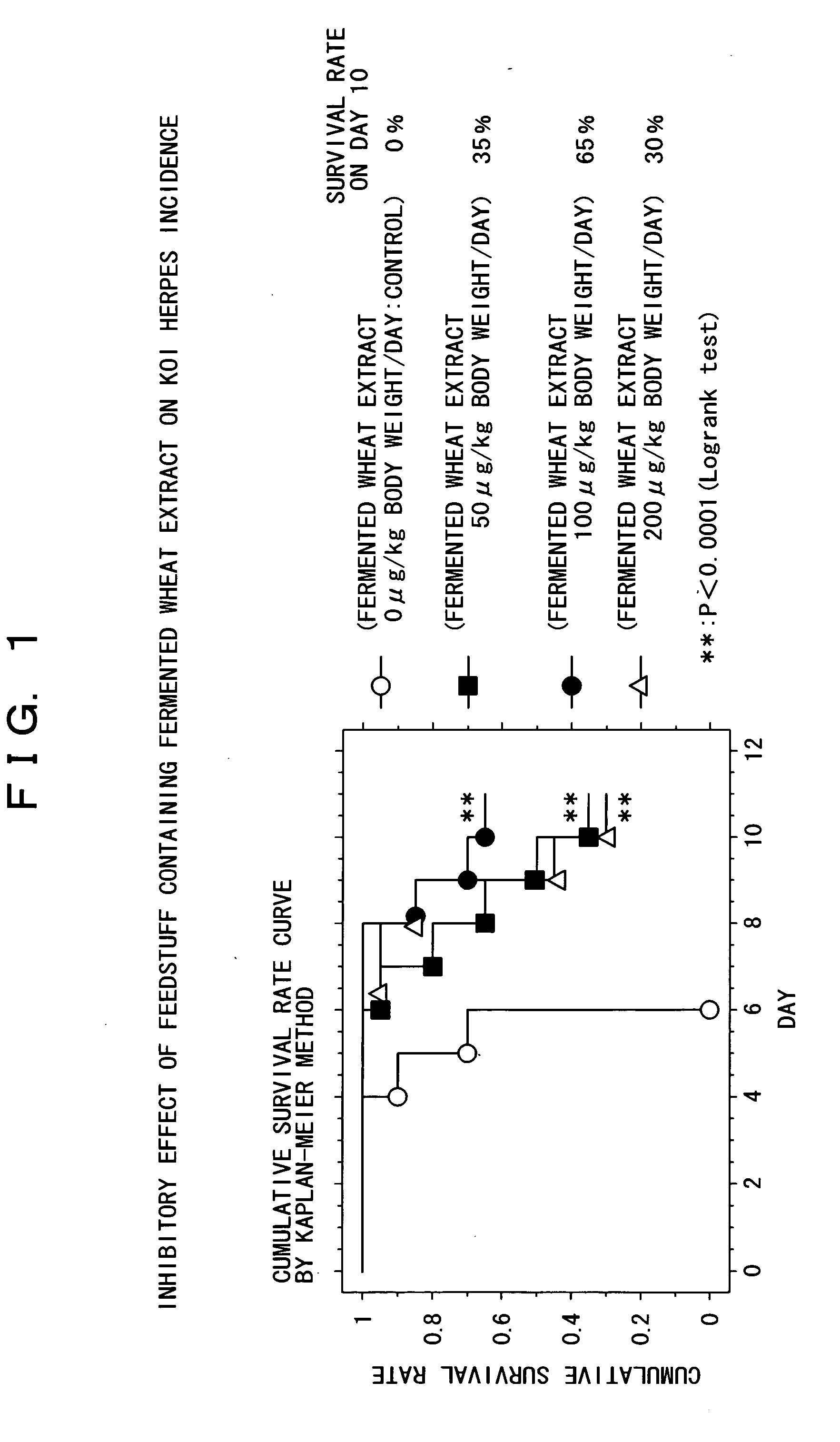Method for fermentation and cultivation, fermented plant extract, fermented plant extract powder, and composition containing the extract of fermented plant
a technology of plant extract and composition, which is applied in the directions of plant/algae/fungi/lichens ingredients, antibacterial agents, unknown materials, etc., can solve the problems of high cost, inability to expect the effect of the immunopotentiator, and general difficulty in keeping an ingested amount of the immunopotentiator appropriate, etc., to achieve safe and inexpensive supply of fermented plant extract, the effect of high safety and inexpensiveness
- Summary
- Abstract
- Description
- Claims
- Application Information
AI Technical Summary
Benefits of technology
Problems solved by technology
Method used
Image
Examples
example 1
Growth Study of Pantoea agglomerans in Wheat Flour Medium
[0080] In order to confirm whether Pantoea agglomerans which is the indigenous symbiotic bacterium with wheat can grow using the wheat flour as the carbon source, the growth of Pantoea agglomerans in a wheat flour solid medium was examined.
[0081] (1) M9 agar medium containing 0.5% wheat flour as the carbon source was made.
[0082] (2) One colony of Pantoea agglomerans was picked up from the LB agar medium, and suspended in 1 ml of PBS. This was sequentially diluted 10 times to 10,000 times, and 0.1 ml of each aliquot was seeded on the M9 agar medium of (1).
[0083] (3) After culturing at 37° C. for 6 days, appearance of colonies was observed. As a result, about 300 colonies were observed in a petri dish in which 0.1 ml of the dilution 10,000 times had been seeded.
[0084] This has confirmed that Pantoea agglomerans can utilize wheat flour as the carbon source.
example 2
Production of Fermented Wheat Extract
[0085] (1) Distilled water (5 ml) was added to 0.5 g of wheat flour to suspend, 0.1 ml of the supernatant was added to the L broth agar medium, and cultured at 37° C. overnight.
[0086] (2) A yellow colony was isolated, a bacterium was identified by the standard methods, Pantoea agglomerans was isolated, this was suspended in 50% glycerol solution, and stored in a freezer. A part of this stock was applied on the LB agar medium, which was left standing at 37° C. to make an independent colony of Pantoea agglaomerans.
[0087] (3) In a 2 liter flask, 64 g of sodium (II) phosphate heptahydrate, 15 g of potassium (I) phosphate, 2.5 g of sodium chloride, and 5 g of ammonium chloride were added and purified water was added to make a total volume one liter (inorganic salt mixed solution). The purified water was added to 13.1 g of magnesium chloride dihydrate to make the total volume 100 ml (magnesium chloride solution). The purified water was added to 11....
example 3
Immunopotentiation Action of Fermented Wheat Extract
[0107] An acute myelogenic leukemia cell line, THP-1 (1×106 / 250 μL, RPMI1640 medium containing 10% fetal calf serum) used as human macrophages were placed in a 48-well plate, and previously precultured for 30 minutes. Subsequently, 250 μL of the medium (final volume 500 μL) was added so that the final concentration of each sample was 1 to 10,000 ng / mL. The samples were provided with a group containing polymyxin B (12.5 μg / mL). After culturing for 4 hours, culture supernatants and the cells were collected. The TNF activity in the supernatant was measured by a cytotoxicity test using L-929. The results are shown in Table 8. The macrophages produced TNF even with the presence of polymyxin B by the fermented wheat extract, but with the presence of polymyxin B, the macrophages could not produce TNF by the low molecular weight lipopolysaccharide and the limulus positive glycolipid. From this, it is obvious that the fermented wheat extr...
PUM
| Property | Measurement | Unit |
|---|---|---|
| total volume | aaaaa | aaaaa |
| total volume | aaaaa | aaaaa |
| total volume | aaaaa | aaaaa |
Abstract
Description
Claims
Application Information
 Login to View More
Login to View More - R&D
- Intellectual Property
- Life Sciences
- Materials
- Tech Scout
- Unparalleled Data Quality
- Higher Quality Content
- 60% Fewer Hallucinations
Browse by: Latest US Patents, China's latest patents, Technical Efficacy Thesaurus, Application Domain, Technology Topic, Popular Technical Reports.
© 2025 PatSnap. All rights reserved.Legal|Privacy policy|Modern Slavery Act Transparency Statement|Sitemap|About US| Contact US: help@patsnap.com

